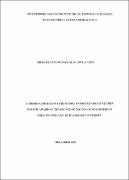| dc.description.abstract | Heavy metals are major environmental pollutants, and their toxicity is a problem of
increasing significance for ecological, evolutionary, health and environmental reasons.
Regular consumption of food and water contaminated with heavy metals exposes the
consumer especially children and women of child bearing age to adverse developmental,
reproductive, neurological, immunological, teratogenic and carcinogenic effects. Data on
the potential risk contribution of heavy metal contaminated water and food towards the
disease burden in Uganda is inadequate. This study aimed to assess heavy metal exposure
and health risks posed to the population in Kampala, through consumption of street
roasted meat (SRM), drinking water and commercial black tea sold in the city.
Twelve samples of each of the street roasted pork, beef, goat, and chicken were randomly
purchased on the streets of Kampala City. Forty seven samples of each of groundwaterfed
protected spring, tap and bottled water were obtained from the five divisions of the
city. Twenty samples of commercial black tea brands were randomly purchased from
supermarkets and retail shops in the five divisions of Kampala City. Street roasted meat
were analysed for lead (Pb), arsenic (As), cadmium (Cd), chromium (Cr), copper (Cu),
zinc (Zn) and iron (Fe) using Atomic Absorption Spectrophotometry. Drinking water and
black tea samples were analyzed for aluminium (Al), mercury (Hg), manganese (Mn) and
nickel (Ni) in addition to the above parameters. Human health risks due to exposure to
toxic elements were determined using the deterministic risk analysis approach described
by the United States Environment Protection Agency (US EPA). Cancer and non-cancer
risks were estimated for both children and adults using incremental lifetime cancer risk
(ILCR) and non-cancer hazard quotient (HQ), respectively. | en_US |

